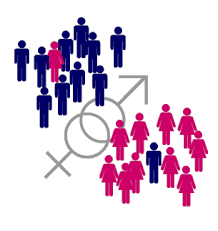
A new study from scientists at the
Ovaries Become Testes
Recent research from the
Dr Treier said, “No one would have believed that an adult organ could be transdifferentiated to such an extent by changing a single gene – that is why the finding is so spectacular.”
Research Challenges Views on Gender
The finding also flies in the face of the general wisdom regarding the male and female sex organs, which has long held that the ovary was in fact the default position of a gonad and that it was simply the Y chromosome that triggered the development of testes.
The research showed that in fact the Y chromosome simply contained an element that expedites the work of a gene called Sox9 – responsible for testicular development. Females also have the Sox9 gene and it is in fact a female gene call Foxl2 that blocks the messages from the Sox9 gene and prevents the ovary from assuming testicular features. The study demonstrated that by switching off the Foxl2 function in females, scientists could instigate a change in the gonad’s physiology – effectively switching it from a female to a male organ.
Dr Treier said, “This shows that the maintenance of the ovarian phenotype is an active process throughout life. Like Yin and Yang, Foxl2 and Sox9 oppose each other's action to ensure together the establishment and maintenance of the different female and male supporting cell types respectively."
While the testes created in this situation are sperm-less and incapable of reproduction, they nevertheless continue to contribute to hormone output, with the “changeling” testes pumping testosterone into the female system and manifesting changes often associated with issues such as gender dismorphia.
Testosterone, the hormone provided to women going through gender reassignment, can cause women’s voices to deepen, promote the growth of male-type facial hair and are believed to play a role in the determination of sexuality and attraction.
Research May Shed Light on Menopause
Researchers have said the changes noted could also explain the phenomenon of female post-menopausal masculinization, theorizing that the work of Foxl2 could be linked to estrogen output, and that with the decline of estrogen in menopause, the Foxl2 gene becomes less capable of blocking the function of Sox9 and the post-menopausal ovary may begin to assume testicular characteristics.
For more information on cutting edge research and new scientific discoveries, please visit: UltraFitnessDynamics

No comments:
Post a Comment